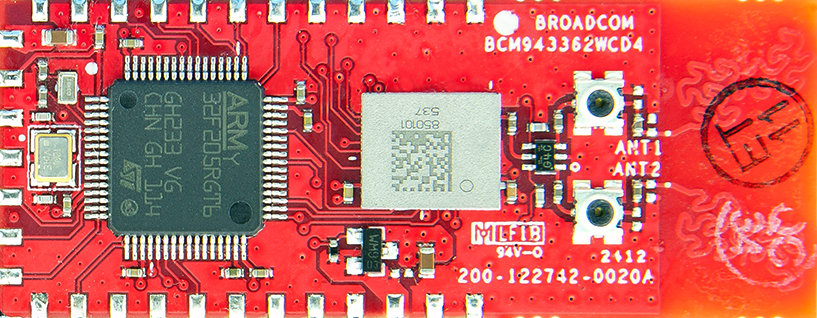WICED -- Wireless Internet Connectivity for Embedded Devices


Broadcom's Wireless Internet Connectivity for Embedded Devices (WICED™) platform (pronounced "wik-id") eases development effort and simplifies the implementation of Internet connectivity in an array of consumer devices, especially those without existing support for networking.
Developers use the WICED platform to create secure wireless networking applications on a wide array of platforms encompassing Broadcom wireless connectivity technologies. The WICED platform encompasses:
- WICED™ Wi-Fi - a development system for Wi-Fi Connectivity
- WICED SMART™ - a development system for Bluetooth Smart (Bluetooth Low Energy) applications

Use the WICED Development System to create secure embedded wireless networking applications on an existing product microcontroller, or on an additional WICED module that includes a microcontroller. Either way, the comprehensive and size-optimized WICED application library and embedded Wi-Fi driver work together with a Broadcom® embedded wireless LAN chip to provide seamless wireless connectivity.
If you need ultra low power wireless, use the included WICED SmartBridge™ API to provide seamless data aggregation and internet connectivity for WICED Smart devices too!
WICED™ Wi-Fi Development Kits
Broadcom provides a WICED Software Development Kit and is working with partners to deliver turnkey hardware solutions to enable Wi-Fi connectivity.
WICED™ Wi-Fi Software Development Kit
The WICED SDK includes
- An open source build system and toolchain based on GNU make (native IAR support coming soon!).
- A GUI Development Environment based on Eclipse CDT that seamlessly integrates with a JTAG programmer and single-step, thread-aware debugger based on OpenOCD and gdb.
- A comprehensive software stack with a choice of several RTOS/TCP stack options includingThreadX/NetX, ThreadX/NetX Duo and FreeRTOS/LwIP.
- Advanced security and networking features such as SSL/TLS, IPv4/IPv6 networking, and mDNS (Bonjour) device discovery.
- Bluetooth Low Energy SmartBridge™ to connect Bluetooth Smart devices to Wi-Fi
- WICED Application Framework including bootloader, flash storage API, over-the-air (OTA) upgrades, factory reset, and system monitor.
- Simple out-of-box device setup using Apple-licensed MFi technology or via a web browser and softAP/webserver.
- Production ready sample applications.
- Lots of application snippets demonstrating how to use the rich WICED API feature set.
- Various test applications to aid manufacturing and certification.
- All documentation included inside the WICED SDK.
The WICED™ Wi-Fi SDK and Documentation can be downloaded here after completing the registration process.
BCM943362WCD4_EVB --- WICED™ Wi-Fi Evaluation Kits

 What is WICED?
What is WICED?- WICED™ is a development system that vastly reduces the effort required to add wireless connectivity to embedded devices.
The SDK enables developers to quickly create network connected applications targeted for low-resource microcontrollers.
 What is included in the WICED™ SDK?
What is included in the WICED™ SDK?The WICED SDK includes :
- An open source build system and toolchain based on GNU make.
- A GUI IDE based on Eclipse CDT that seamlessly integrates with a programmer and single-step, thread-aware, debugger based on OpenOCD and gdb.
- A complete software stack that includes advanced security and networking features such as SSL/TLS, IPv4/IPv6 networking, and mDNS/Bonjour.
- Production ready example applications.
 Which Operating Systems does the SDK run on?
Which Operating Systems does the SDK run on?- The WICED SDK runs on all major operating systems including Windows®, Mac OS X and Linux.
 How much does the SDK cost?
How much does the SDK cost?- The SDK is available free when developing applications on microcontrollers connected to Broadcom Wi-Fi products.
 Which RTOS & Network Stacks are available with the SDK?
Which RTOS & Network Stacks are available with the SDK?- Two options are available: a commercial option which is provided as linkable object files, and an open source option. Both options are free when used with microprocessors connected to a Broadcom Wi-Fi chip. The commercial option, ThreadX/NetXDuo from Express Logic, provides full IPv4 and IPv6 networking functionality. The open source option, FreeRTOS/LwiP only provides IPv4 networking functionality.
 What if I want to use a different RTOS or Network Stack?
What if I want to use a different RTOS or Network Stack?- The WICED™ API abstracts the RTOS & networking stack in an attempt to avoid the need for developers to interact directly with these software components. The abstraction layer is written to minimize the effort required to port to other RTOS & Network Stacks if desired.
 Does the SDK support Wi-Fi Protected Setup (WPS)?
Does the SDK support Wi-Fi Protected Setup (WPS)?- Yes. WPS 1.0 and 2.0 are supported. The WPS supplicant runs on the microcontroller.
 How much Flash and RAM does my application need?
How much Flash and RAM does my application need?- Application resource requirements vary depending on networking and security features required by the application. Most applications require at least 512kB Flash memory and 64-128kB RAM.
 Where do I buy WICED™ evaluation boards?
Where do I buy WICED™ evaluation boards?- WICED™ modules and evaluation boards are available from Broadcom, ODMs and third-party distributors here.
 Does WICED™ support SSL/TLS security?
Does WICED™ support SSL/TLS security?- Yes. WICED™ supports TLS up to version 1.1. Coupled with the included http client and http server modules, WICED™ supports full HTTPS encryption. The SSL/TLS supplicant runs on the microcontroller.
 Which Microcontrollers are supported by the SDK?
Which Microcontrollers are supported by the SDK?- The SDK supports a range of STM32 microprocessors from ST Microelectronics, the SAM4 series from Atmel and Kinetis K60 from Freescale. Support for microprocessors from additional vendors is in progress.
 Does the WICED™ SDK support a SEP2.0 stack?
Does the WICED™ SDK support a SEP2.0 stack?- Yes. A SEP2.0 stack for WICED™ is available from one of Broadcom's partners. Please contact Broadcom sales to obtain further details.
 Does the WICED™ SDK support Wi-Fi Direct?
Does the WICED™ SDK support Wi-Fi Direct?- Yes. The core features of Wi-Fi Direct (softAP, DHCP server and WPS) are available as part of the WICED™ SDK.
 Does the Wi-Fi security supplicant run on the microcontroller?
Does the Wi-Fi security supplicant run on the microcontroller?- No. The Wi-Fi security supplicant runs on the Broadcom Wi-Fi chip.
 Where do I get support?
Where do I get support?- General support for the WICED Development System is available on the WICED forum.
WICED -- Wireless Internet Connectivity for Embedded Devices的更多相关文章
- 论文翻译:2020_Lightweight Online Noise Reduction on Embedded Devices using Hierarchical Recurrent Neural Networks
论文地址:基于分层递归神经网络的嵌入式设备轻量化在线降噪 引用格式:Schröter H, Rosenkranz T, Zobel P, et al. Lightweight Online Noise ...
- WM-N-BM-09 WM-N-BM-14
USI Delivers WICED Module to Gain Great Success Customers Broadcom’s Wireless Internet Connectivity ...
- [转]A Guide To using IMU (Accelerometer and Gyroscope Devices) in Embedded Applications.
原文地址http://www.starlino.com/imu_guide.html Introduction There’s now a FRENCH translation of this art ...
- Smart internet of things services
A method and apparatus enable Internet of Things (IoT) services based on a SMART IoT architecture by ...
- Single-stack real-time operating system for embedded systems
A real time operating system (RTOS) for embedded controllers having limited memory includes a contin ...
- 微软职位内部推荐-SW Engineer II for Embedded System
微软近期Open的职位: Do you have a passion for embedded devices and services?   Does the following m ...
- Methods for Using Message Queuing Telemetry Transport for Sensor Networks to Support Sleeping Devices
Methods support a sleep mode for an embedded device. Embedded devices like sensors and actuators use ...
- 无线电源传输 Wireless Power Consortium (WPC) Communication
Universally Compatible Wireless Power Using the Qi Protocol Wireless charging of portable electronic ...
- Using QEMU for Embedded Systems Development
http://www.opensourceforu.com/2011/06/qemu-for-embedded-systems-development-part-1/ http://www.opens ...
随机推荐
- Machine Learning系列--归一化方法总结
一.数据的标准化(normalization)和归一化 数据的标准化(normalization)是将数据按比例缩放,使之落入一个小的特定区间.在某些比较和评价的指标处理中经常会用到,去除数据的单位限 ...
- C基础 如何让代码只执行一次
1.0 最简单, 最高效的方式 C 代码运行起点 main 就是个大单例函数. 如果把函数注册在其里面, 那么一定很可以 :) // 某个库需要初始化的函数 void log_init(void) { ...
- C++学习笔记--从虚函数说开去
虚函数与纯虚函数: 虚函数:在某基类中声明为virtual并在一个或多个派生类中被重新定义的成员函数,virtual 函数返回类型 函数名(参数表){函数体;} ,实现多态性,通过指向派生类的基类 ...
- Mybatis的初步使用
MyBatis 是当下最流行的持久层框架,也是ORM框架,本是apache的一个开源项目iBatis, 2010年这个项目由apache software foundation 迁移到了google ...
- beego学习笔记(4):开发文档阅读(1)
1.beego的设计是高度模块化的.每个模块,都可以单独使用.一共八大模块: cache;session;log;orm;context;httplibs;toolbox 2.beego的执行逻辑 3 ...
- vim 图册
网上看到的一些图,感觉不错,分享一下 我现在感觉配置文件,很多没有必要,反而很花哨,但是这些基础的东西,反而很高效,实在 VIM的列编辑操作 删除列 1.光标定位到要操作的地方. 2.CTRL+v 进 ...
- java 反射 报错:Attempt to get java.lang.Integer field "..." with illegal data type conversion to int
类: Integer id; 反射时: Field f = User.class.getDeclaredField("id"); f.setAccessible(true); in ...
- Windows环境上装在VM,VM安装CentOS7
1.下载VM并且安装 VM下载地址:https://www.vmware.com/products/workstation-pro.html 来自百度经验的的一个密钥(VMware Workstati ...
- 无框架完整搭建安卓app及其服务端(一)
技术背景: 我的一个项目做的的是图片处理,用 python 实现图片处理的核心功能后,想部署到安卓app中,但是对于一个对安卓和服务器都一知半解的小白来说要现学的东西太多了. 而实际上,我们的项目要求 ...
- Arduino可穿戴教程之第一个程序——上传运行程序(四)
Arduino可穿戴教程之第一个程序——上传运行程序(四) 2.4.5 上传程序 现在所有Arduino IDE的设置都完成了,我们就可以将示例程序上传到板子中了.这非常简单,只需要单击如图2.45 ...
